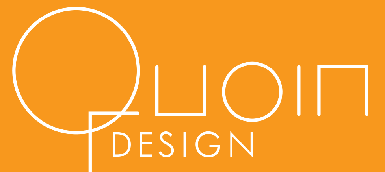A creative brief document outlines the goals that a design project must meet, as well as strategies for reaching the goal and any other major requirements. This communication tool helps ensure that the designer, client and any other stakeholders are all on the same page. Quoin uses the creative brief as a tool to keep projects on track.
Creating a Smooth Design Process
Most importantly, the creative brief removes a lot of subjectivity inherent in design. It does this by stating everything in terms of business goals rather than subjective likes and dislikes.
This helps speed up and smooth out the design feedback process, saving time and money. In this way, it can fulfill another major need by giving the internal side of the client review team a way to talk about the project with both supervisors and direct reports. Getting buy-in is especially valuable as the design nears production and must be launched.
Creative Brief Format
The creative brief format we use answers the most basic questions, such as:
- Design Team
- Audience
- Competitive advantage
- Objectives/Metrics
- Message
- Timelines
- Budget for design and production
The Parts of A Creative Brief
Design Team
Careful definition of the design team is a central part of the design process. This could be an article in itself. But the short version is that the brief spells out all of the people who will have input and/or approval power.
Also, we try to be sure all of these people are in the creative brief intake meeting. Otherwise, information must be pushed up the org chart and accurate feedback must make its way back down, which can add a lot of extra time. A good beginning helps to create a good end.
Audience
Above all, we create detailed demographics and clear market definitions. So, we need to be sure to segment your market into manageable pieces that can be accurately targeted, saving you wasted effort.
For instance, if we’re creating a brief for a new website, we don’t stop with “Women between 35 and 45”, we create personas such as “Female entrepreneurs between 35 and 45 who want to offload their A/R processes and improve invoice payment times.” In this way, the call-to-action almost writes itself. Sometimes the client’s marketing department can take care of this step, and sometimes we help craft it.
Competitive Advantage
No business exists in a vacuum. When customers make decisions about what to buy, they look for reasons to differentiate you from other companies. So, we need to give them a compelling reason to buy from you rather than your competitor.
Also, we state the competitive advantage in plain language, avoiding adjectives like “unique”, “innovative”, or, God forbid “impactful”. With just the facts, we’re better able to forge a truly unique way of wording your advantage. This will get you much more notice than using superlatives and vague terms.
Objectives/Metrics
Each objective in the creative brief should be connected to a business strategy. So, instead of saying, “We’ll grow our market by 5%”, it’s more productive for us to say “We’ll grow our market by 5% by increasing client awareness of our intellectual property defense experience”.
Messages
We write down any offers or calls to action in this section. Also, we add any information that will help prove your advantage: supporting data, specifications, and trust signals such as client testimonials.
Timelines
Everyone needs everything yesterday, but the surest way to delay a project is to mark it ASAP. Instead, setting clear and reasonable deadlines is more productive.
Production times for services such as printing can have a large effect on the feasibility of a deadline. In addition, clients sometimes underestimate the length of a design process because time for building internal consensus was not carefully thought through.
Budget
There are always at least two budgets: design and production. Often the production budget must be set before the design budget can be estimated.
For instance, to create a gift box for a client, we need to know size, quantity, number of colors we’ll be printing, etc. One box in one size, printed with one color in a small spot on the top will be a very different design budget (and timeline) from 3 boxes in three sizes, printed all over in 4 colors.
Other Vital Information
In addition, other important needs should be addressed in the creative brief, such as:
- Whether the design product needs to work within an existing campaign.
- How will the design product get to the audience/customer?
- Production necessities
- Mandatory information such as required certifications (such as those required by financial regulations), industry association badges, etc.
The Creative Brief Process Doesn’t Interfere With Deadlines
We keep this process very straightforward. If you don’t have much time, we just get the essentials down in writing by using a succinct format.
A short format creative brief (a brief brief?) can be as simple as:
- Design review team with contact information
- Audience
- Objectives
- Deadline
- Budget
- Production needs
In this way, we can prevent mission drift and increase the chances that your tight deadline is hit.
A More Productive Project
Good creative briefs create good design results. We always take at least a little time to get the stated goals down on paper so that everyone agrees on the road map. It saves you time and money and often… sanity.








